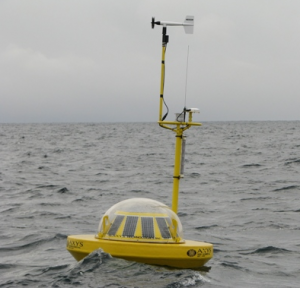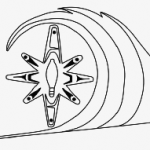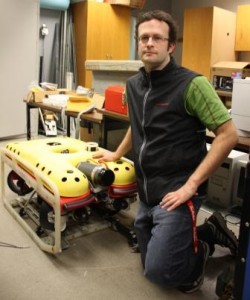I live on an island (Vancouver Island) surrounded by ocean. Oceans make up over 70% of the Earth’s surface. Our proximity to this abundant resource is obvious. The energy-giving capacity of that resource is less clear. To better understand what that capacity is, the West Coast Wave Collaboration Project (WCWCP) kicked-off in June 2009. This project has been in the news recently and I wanted to learn more. So, I visited with Brad Buckham, mechanical engineer, instructor in the University of Victoria – Institute for Integrated Energy Systems, and lead investigator on the project.
This two-year project, co-funded by the Government of Canada, will use wind, wave and tidal data collected from a single fixed buoy, located offshore near Ucluelet, on Vancouver Island’s west coast.
The WCWCP will develop modeling expertise, advance the development of wave energy projects in BC, and provide critical information to wave energy device developers. Data-gathering and model development during the project will assist planning and project developers in the wave energy industry, channel wave energy research at universities, and help guide policy and program development by government and regulators.
The partners and their contributions to the WCWC project
This project demonstrates how people and organizations can work together, to collaborate, to address big challenges, e.g., our collective needs for renewable energy.
Here’s a list of the project partners and their key areas of contribution:
| Natural Resources Canada (federal government) | Funds and Support |
| University of Victoria | Technical management, modelling expertise, instrumentation, insurance, storage, overhead |
| BC Hydro (utility) | Financial support |
| Fred Olsen Marine Renewables (private developer) | Contribution of permitted site for use during program and funds towards operations |
| AXYS Technologies (monitoring device provider) | Technical, operations, custom buoy, deployment services, materials |
| Natural Power (consultant) | Permitting, operational/deployment support, stakeholder engagement, modelling |
| Triton Consultants (consultant) | Funding, In-house software, technical and supervisory services |
| District of Ucluelet (local municipality) | Harbour Master and Public Works support; closest major land community |
| Ucluth Development Corporation & Ucluelet First Nation (First Nations) | Buoy monitoring by fisherman, logo, artwork, website posting |
| Black Rock Resort (tourism) | IT, communications, onsite support |
This type of collaborative doesn’t happen over night. A number of the partners already had relationships with each other, through their involvement in the Ocean Renewable Energy Group (OREG) an organization that aligns industry, academia and government to ensure that Canada is a leader in providing ocean energy solutions to a world market.
University of Victoria’s role
The University of Victoria plays a coordinating role in the WCWCP. In addition to securing federal government funding, the University is also uniquely positioned in other ways. In this short 2-minute video clip, Brad Buckham touches on some of those ways: (click here if you can’t see the video)
In summary, involvement of the University is important because it:
- Is a relatively neutral partner, well positioned to mediate stakeholder interests
- Offers promise of future leverage; e.g., with any follow-on project/work opportunities
- Contributes young, energetic, inventive minds to the project, who also represent potential, post-project, intellectual capital that might be available (e.g., employment) to the community
- Is willing to do some of the dirty, time consuming work; this helps keep up the project momentum
- Delivers good documentation/research work = publicity opportunity for partners involved
What makes WCWCP an innovative collaboration?
Consistent with innovation best practices I surveyed (e.g., see my post 39 Insights into the makeup of innovative teams: From the 2009 IdeaConnection interviews), the WCWCP is innovative because of its:
- Membership; diverse team, sectors, expertise, contributions
- Structure: partner autonomy within the boundaries of a University/ federal agreement; diverse membership within a relatively small, action-oriented core team
- Motivation; each partner bringing their gifts to the project; individual and collective learning
- Thinking;
- address the big question (what are the waves actually doing?)
- broad-bandwidth (fitting a little peg WCWCP – into the bigger picture of national and international data banks)
- integrate with, add to, existing building blocks (using freeware, where possible, to maximize accessibility)
- long-term growth and sustainability
- reduce the gap (between knowledge of seas and capacity to innovate)
- a sense of urgency (to move the file forward);
- Involve local communities (municipal, business, First Nations)
- Continuous public outreach and engagement (related to WCWCP)
- Funding; project funding (<200k, direct & InKind) is low compared with the degree of collaboration between the partners (high); less $ = more collaboration?!
Find out more
To learn more about the WCWCP, its genesis, objectives, cool maps and photos related to the project click here to see a PDF of a presentation made about the WCWCP, at the OREG Victoria Symposium, October 19, 2009.
Question for the reader
What aspect of this project speaks most, to you, about collaboration and/or innovation?
If you enjoyed this post, please consider leaving a comment or subscribing to my blog. Thanks, Ben.




Speak Your Mind